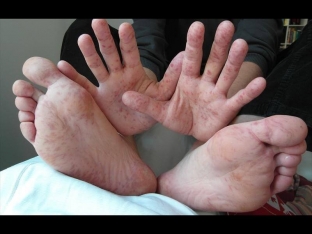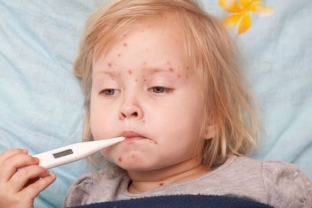Summer vacation this year for some tourists was overshadowed by an unpleasant disease known to the world as the Coxsackie virus, the treatment took time and took away many wonderful minutes of swimming, sunbathing, etc. In different countries, this virus showed its activity, there were fatal cases. So, it's time for everyone to learn as much as possible about the symptoms of the Coxsackie virus, treatment and prevention. estet-portal.com learned all the details about the disease with such a strange name, what it is, how it proceeds and is transmitted from carriers, how it differs from other viruses and what dangers it poses.
Coxsackievirus: first treated in 1948
This disease is named after the American town where polio researcher Gilbert Dalldorf first isolated strains of the virus from feces. And although more than 60 years have passed, even far from all doctors know about such a disease. This is partly due to the fact that Coxsackie suffers mainly from children aged 3-10 years. Partly – the fact that viruses like to disguise themselves as each other, and full-fledged diagnostics in medical institutions are not always carried out.
An important point – under the name "Coxsackie" in fact, a whole bunch of viruses is hiding – 29 serotypes have been identified to date. They do not differ much in symptoms from each other. And, in fact, all manifestations come down to three subspecies of enterovirus, which, as you know, likes to multiply in the gastrointestinal tract (stomach and intestines).
The Coxsackievirus sometimes claims lives, although it is considered a harmless childhood infection. Many types of viruses with the same symptoms externally manifest themselves as three types of enteroviruses.
What are the symptoms of Coxsackie – treatment for different subtypes
Any virus lives in cells, and from there it starts its attack on the human body. Once in a new body, at first Coxsackie multiplies, accumulating in the cells of the mucous membranes of the nasopharynx, small intestine and nearby lymphoid tissues.
The following happens in the body:
- virus particles massively enter the circulatory system, circulating through it;
- the virus gets to various organs, settles in their cells, provoking inflammation, – and most of all, Coxsackie likes to settle in skin cells, kidneys, liver, striated muscles, neurocytes;
- all of this calls "to battle" human immunity, his fighters are activated – T lymphocytes, and a war for recovery begins inside the body.
Coxsackie is a common virus that infects the body's cells. Once inside a person, it multiplies and circulates in the blood. In this case, the accumulation of virus particles in a number of internal organs is possible.
How the disease manifests itself outwardly
Symptoms are as follows:
- Acute onset in the form of high temperature (up to 39). If the immune system is in order, then after 3-4 days the temperature drops to normal. In the meantime, my head and muscles still hurt. The patient as a whole feels very ill, which is typical for any virus. But further, in a day, the peculiarities begin.
- Fluid blisters and sores appear on the extremities (between the fingers, on the palms, on the soles of the feet). Also inside the oral cavity on the mucosa – first of all, on the palate, the inner surface of the cheeks, but possibly also on the tonsils. In severe cases, the forearms and buttocks are also affected. The bubbles are up to 2 mm in diameter. They are painful, but, fortunately, there is no itching.
- Diarrhea starts up to 10 times a day. Vomiting will most likely also occur. The stool is loose, but should be free of mucus, blood, and pus.
- In some cases, patients reported that their fingernails were peeling off.

Important! If you are "lucky" get infected with enterovirus type A, then you can count on a quick recovery. If "caught" other subtypes are much more dangerous – there is a serious risk of developing meningitis, encephalitis, damage to the heart and liver, pleura and pancreas. Muscle paralysis is also possible, most likely still temporary. In this case, treatment should be carried out appropriate to the complication. The good thing is that this rarely happens.
Distinctive features of the Coxsackie virus – rash on the arms, legs and oral mucosa, high fever, pain in the head and muscles, diarrhea, vomiting. Intoxication characteristic of any virus is also attached.
How is Coxsackie treated
The Coxsackie virus itself, in fact, is not subject to treatment, like any other similar cellular "conqueror". Therapy that alleviates general well-being and treatment aimed at eliminating symptoms – due to their soreness.
As a result, with the diagnosis of Coxsackie, the treatment is as follows:
- bed rest;
- intoxication is removed by drinking – avoid dehydration, in difficult cases it is possible to take antiviral drugs;
- to protect yourself from the effects of diarrhea, take Regidron or a similar remedy;
- calm for the stomach anti-inflammatory diet, taking into account the presence of vomiting and diarrhea;
- to muffle the pain in the muscles, in the head, to lower the temperature, they take anti-inflammatory drugs, children are shown Ibuprofen;
- treat skin rash with brilliant green or furatsilin;
- the same furatsilin or other antiseptic is used to rinse the oral cavity with rashes on its mucous membrane, the gel used for gums at the time of teething also helps;
- use sprays for a sore throat;
- Antihistamines are indicated;
- Rinse your mouth after eating.
Important! Antibiotics do not help against viruses, therefore they are excluded from Coxsackie. Unfortunately, there is no vaccine.
Within 3 days, relief should come, and in 8-10 days – cure. If this did not happen – to the doctor urgently! Coxsackie does not require special treatment in mild cases, like any virus. The patient must drink a lot. He is on a diet. Therapy is aimed at relieving and eliminating symptoms.

How Coxsackie is transmitted – replace treatment with prevention
In principle, this disease is considered to be a childhood disease. But adults also get sick. And it is typical not only for disadvantaged areas, where there is a lot of dirt. Newborns rarely get sick due to their mother's immunity.
The number of ways to infect is extensive:
- this infection is on the list of waterborne diseases;
- unwashed fruits/vegetables;
- by air – if there is a threat of infection, do not go to crowded places;
- through contact with hands and other parts of the body – it is important to wash your hands;
- through dishes and other similar household items;
- sometimes the strain persists in faeces for up to 780 days, so avoid contact with them for this reason as well, we keep household toilets clean, and dispose of hygiene products immediately after use.
If the infection does occur, it appears within 2-10 days.
Hygiene, cleanliness in the house, especially in sanitary facilities, helps to avoid infection. It is important to keep dishes clean, eat fresh food and drink well-purified water.
Coxsackie virus – disease with unpleasant symptoms. A painful rash on the skin and mucous membranes in the mouth may be painful but should not itch. If it is accompanied by muscle pain, fever, diarrhea, vomiting, this diagnosis can be suspected. Only laboratory tests can confirm it 100%. The disease is transmitted in all sorts of ways, but banal cleanliness and personal hygiene helps to avoid it. If Coxsackie had to fall ill, treatment occurs in the direction of eliminating the consequences of the symptoms – each one separately. And it is important to drink a lot because of intoxication. Maximum 7-10 days – and the enterovirus must leave the body. If this does not happen or other symptoms appear, you should definitely see a doctor in order to avoid complications.








Add a comment